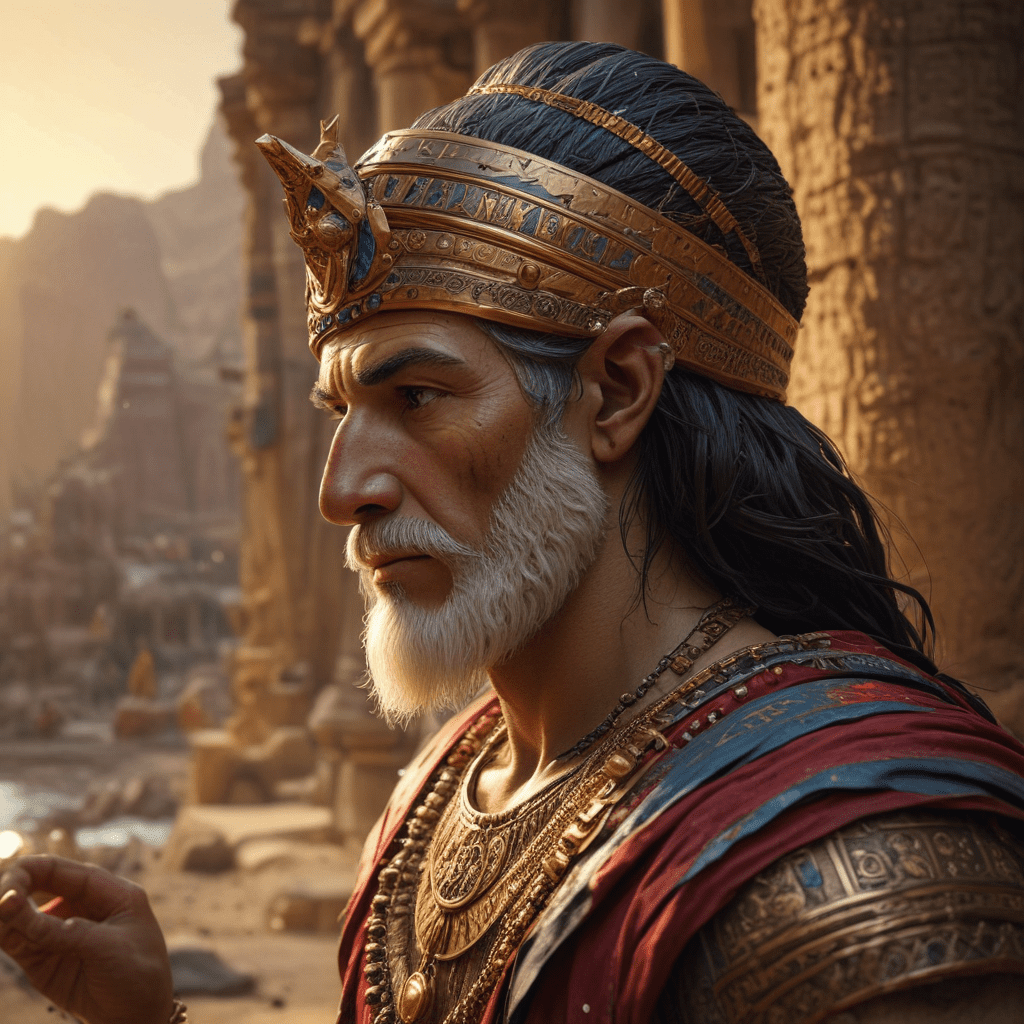1. Introduction
1.1 Mesopotamian Mythology: A World of Gods, Heroes, and Myths
Mesopotamian mythology, born amidst the fertile valleys of the Tigris and Euphrates rivers, is a rich tapestry of stories, beliefs, and rituals that shaped the ancient world. Its pantheon of gods, intricate creation myths, and epic tales continue to captivate and inspire us today.
1.2 A Legacy of Influence
The influence of Mesopotamian mythology extended far beyond its geographical boundaries. Neighboring cultures, from Canaan to Egypt, adopted and adapted its deities, myths, and religious practices. This cross-pollination of ideas shaped the religious landscape of the ancient Near East, leaving an enduring mark on history.
2. The Pantheon of Mesopotamian Gods
2.1 A Hierarchy of Power and Authority
The Mesopotamian pantheon was a complex hierarchy of deities, each with their own domain, attributes, and sphere of influence. At the apex stood the triad of Anu, the sky god; Enlil, the god of air and storms; and Ea, the god of water and wisdom. These deities ruled over a vast array of lesser gods and goddesses, each responsible for specific aspects of life, nature, and the cosmos.
2.2 Divine Personalities and Relationships
The Mesopotamian gods were not abstract entities but rather anthropomorphic figures with human-like emotions, motivations, and relationships. They could be benevolent and protective, but also wrathful and vengeful. Myths and stories depicted their interactions, rivalries, and alliances, offering insights into the Mesopotamian worldview.
3. Mesopotamian Creation Myths
3.1 From Chaos to Order: The Birth of the World
Mesopotamian creation myths, such as the Enuma Elish, narrated the emergence of the world from a primordial state of chaos. The stories described the struggles of the gods against the forces of disorder, culminating in the establishment of cosmic order and the creation of humanity.
3.2 Humanity's Place in the Cosmos
These myths addressed profound questions about existence, purpose, and humanity's place in the grand scheme of things. They emphasized the divine origin of humans, tasked with maintaining order and fulfilling the will of the gods on earth.
4. The Epic of Gilgamesh: A Literary Masterpiece
4.1 A Journey of Self-Discovery and Mortality
The Epic of Gilgamesh, one of the oldest surviving literary works, tells the tale of a legendary king who embarks on a quest for immortality. Through his adventures and encounters with various characters, Gilgamesh confronts the realities of life and death, ultimately gaining wisdom and understanding.
4.2 Exploring Existential Questions
The epic raises timeless questions about human existence, mortality, friendship, and the search for meaning. It delves into the complexities of human nature and the desire to transcend limitations, offering profound insights into the human condition.
5. Mesopotamian Rituals and Practices
5.1 Connecting with the Divine: Rituals and Offerings
Religious rituals and practices played a central role in Mesopotamian society. Offerings, sacrifices, and elaborate temple ceremonies aimed to appease the gods, seek their favor, and maintain cosmic balance. These rituals were a means of connecting with the divine and ensuring the well-being of the community.
6. The Spread of Mesopotamian Beliefs
The influence of Mesopotamian mythology and religious practices extended far beyond its borders, reaching neighboring cultures and shaping their religious landscapes. This cross-pollination of ideas resulted in the adoption and adaptation of Mesopotamian deities, myths, and rituals in various regions.
Canaanite Religion: Shared Deities and Syncretism
Canaanite religion, practiced in the ancient Levant, borrowed heavily from Mesopotamian mythology. The Canaanite pantheon included deities with clear parallels to their Mesopotamian counterparts, such as El (cognate with Anu), Baal (cognate with Hadad), and Asherah (cognate with Ishtar). These deities were often syncretized, blending Mesopotamian attributes with local Canaanite beliefs.
Egyptian Religion: Echoes of Mesopotamian Influence
Mesopotamian mythology also left its mark on ancient Egyptian religion. While Egyptian mythology had its own unique character, it shared certain themes and concepts with Mesopotamia. The idea of a divine creator, the importance of maintaining cosmic order, and the belief in an afterlife were all present in both traditions.
Anatolian Religions: Transmission and Adaptation
Mesopotamian mythology and religious practices also reached Anatolia (present-day Turkey), where they were adapted and integrated into local belief systems. The Hittite, Hurrian, and Luwian cultures all incorporated Mesopotamian deities and myths into their pantheons. For example, the Hittite storm god Teshub shared similarities with the Mesopotamian god Adad.
7. The Influence on Canaanite Religion
The influence of Mesopotamian mythology on Canaanite religion was profound. Canaanite deities often mirrored Mesopotamian counterparts in their attributes and roles. For instance, El, the supreme god in the Canaanite pantheon, shared similarities with Anu, the Mesopotamian sky god. Baal, the Canaanite storm god, was closely associated with the Mesopotamian god Hadad.
Syncretism and Cultural Exchange
Syncretism played a significant role in the transmission of Mesopotamian beliefs to Canaan. Canaanite deities often absorbed attributes and characteristics of their Mesopotamian counterparts, creating hybrid figures that reflected the cultural exchange between the two regions. This fusion of beliefs demonstrates the fluidity of religious boundaries in the ancient Near East.
Shared Themes and Ritual Practices
Beyond individual deities, Mesopotamian mythology also influenced broader themes and ritual practices in Canaanite religion. The concept of a divine creator, the importance of maintaining cosmic order, and the belief in an afterlife were all present in both traditions. Canaanite rituals and offerings often mirrored those found in Mesopotamia, reflecting the shared cultural heritage of the two regions.
8. The Influence on Egyptian Religion
Mesopotamian and Egyptian mythologies, while distinct in many ways, shared certain themes and concepts. The idea of a divine creator, the importance of maintaining cosmic order, and the belief in an afterlife were all present in both traditions. These shared elements suggest a possible influence of Mesopotamian mythology on Egyptian religious beliefs.
The Concept of a Divine Creator
Both Mesopotamian and Egyptian mythologies featured creation myths that attributed the creation of the world to a divine being. In Mesopotamia, the god Marduk was credited with shaping the world from primordial chaos. In Egypt, the god Atum was believed to have emerged from the primordial waters and created the world through his self-generative power.
Maintaining Cosmic Order
The concept of maintaining cosmic order was central to both Mesopotamian and Egyptian religions. In Mesopotamia, the gods were seen as responsible for upholding the established order of the universe, ensuring the continuation of life and civilization. Similarly, in Egypt, the god Ma'at personified cosmic order, and maintaining balance and harmony was essential for the well-being of the world.
Belief in an Afterlife
Both Mesopotamian and Egyptian religions believed in an afterlife where the deceased would be judged based on their actions in life. In Mesopotamia, the underworld was a shadowy realm ruled by the goddess Ereshkigal. In Egypt, the deceased faced judgment by Osiris, the god of the underworld, and their hearts were weighed against the feather of truth.
9. The Influence on Anatolian Religions
Mesopotamian mythology and religious practices had a significant impact on the Anatolian region, influencing the development of Hittite, Hurrian, and Luwian religions. These cultures adopted and adapted Mesopotamian deities, myths, and rituals, integrating them into their own belief systems.
The Hittites: Adoption and Adaptation
The Hittites, an Indo-European people who ruled over much of Anatolia from the 17th to the 13th centuries BCE, adopted many Mesopotamian deities into their pantheon. The Hittite storm god Teshub shared similarities with the Mesopotamian god Adad, while the Hittite sun goddess of Arinna was cognate with the Mesopotamian goddess Ishtar.
The Hurrians and Luwians: Shared Pantheon
The Hurrians and Luwians, other Anatolian cultures, also shared a pantheon with Mesopotamian influences. The Hurrian storm god Teshub was closely associated with the Hittite Teshub and the Mesopotamian Adad. The Luwian sun goddess of Arinna was also cognate with the Mesopotamian Ishtar.
Mesopotamian Rituals and Practices
Mesopotamian rituals and practices were also adopted and adapted in Anatolian religions. The Hittites, Hurrians, and Luwians all performed rituals and offerings that mirrored those found in Mesopotamia. These shared practices demonstrate the cultural exchange and religious syncretism that occurred in the ancient Near East.
10. Conclusion
Mesopotamian mythology exerted a profound influence on the religious landscapes of the ancient Near East. Its deities, myths, and rituals were adopted and adapted by neighboring cultures, shaping their beliefs and practices. The transmission of Mesopotamian mythology demonstrates the fluidity of religious boundaries and the interconnectedness of ancient societies.
FAQ
What are the key features of Mesopotamian mythology?
Mesopotamian mythology is characterized by its rich pantheon of gods, intricate creation myths, epic tales, and emphasis on maintaining cosmic order.
How did Mesopotamian mythology influence other cultures?
Mesopotamian deities, myths, and rituals were adopted and adapted by neighboring cultures, including Canaanite, Egyptian, and Anatolian religions.
What are some examples of Mesopotamian deities found in other cultures?
- El (Canaanite) – cognate with Anu (Mesopotamian)
- Baal (Canaanite) – cognate with Hadad (Mesopotamian)
- Asherah (Canaanite) – cognate with Ishtar (Mesopotamian)
- Teshub (Hittite) – cognate with Adad (Mesopotamian)




